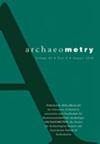游牧民族用熔融铸铁炼钢的时间尺度
IF 1.5
3区 地球科学
0 ARCHAEOLOGY
引用次数: 0
摘要
在蒙古草原出土的铁器碎片中,多次观察到由直径约 50 μm 的珠光体粗球状颗粒组成的结构。这种结构说明了熔融铸铁在快速脱碳降低碳含量的驱动下发生等温凝固反应的过程。根据简化的扩散控制模型预测,一旦铸铁在氧化环境中达到完全熔融状态,反应几乎会立即完成。这种技术显然是小规模炼钢的有效工艺,尤其是在边缘草原环境中。本文章由计算机程序翻译,如有差异,请以英文原文为准。
The time scale of nomadic steelmaking from molten cast iron
A structure consisting of roughly spherical particles of pearlite approximately 50 μm in diameter has repeatedly been observed in iron fragments excavated from across the Mongolian steppe. This structure illustrates a treatment where molten cast iron was subjected to an isothermal solidification reaction driven by the lowering of its carbon level through rapid decarburization. A simplified diffusion-controlled model predicts that the reaction will be completed almost instantly once the cast iron reaches the fully molten state in an oxidizing environment. The technique apparently served as an effective process for small-scale steelmaking, particularly in marginal steppe environments.
求助全文
通过发布文献求助,成功后即可免费获取论文全文。
去求助
来源期刊

Archaeometry
地学-地球科学综合
CiteScore
3.60
自引率
12.50%
发文量
105
审稿时长
6 months
期刊介绍:
Archaeometry is an international research journal covering the application of the physical and biological sciences to archaeology, anthropology and art history. Topics covered include dating methods, artifact studies, mathematical methods, remote sensing techniques, conservation science, environmental reconstruction, biological anthropology and archaeological theory. Papers are expected to have a clear archaeological, anthropological or art historical context, be of the highest scientific standards, and to present data of international relevance.
The journal is published on behalf of the Research Laboratory for Archaeology and the History of Art, Oxford University, in association with Gesellschaft für Naturwissenschaftliche Archäologie, ARCHAEOMETRIE, the Society for Archaeological Sciences (SAS), and Associazione Italian di Archeometria.
 求助内容:
求助内容: 应助结果提醒方式:
应助结果提醒方式:


